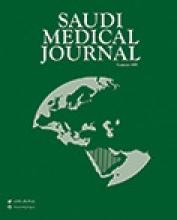Abstract
OBJECTIVE: Many techniques have been described for the treatment of patients with sacrococcygeal pilonidal disease. No data exists, in relation to this disease within the Kingdom of Saudi Arabia. The aim of this paper is to evaluate our technique retrospectively for management of pilonidial disease with regard to cure and recurrence rates.
METHODS: All patients treated at King Faisal Specialist Hospital with either pilonidal abscess or sinus between 1990 and 1998 were identified from the colorectal database and details concerning their presentation, surgery and follow-up were obtained from the patients charts. Both patients with pilonidal sinus and abscess were managed by laying open. Patients were followed until their wounds had healed.
RESULTS: Ninety-eight patients, 12 females and 86 males were treated for pilonidal disease in an 8-year period. All patients were managed by laying open. Thirty-one had had previous surgery. Seventy-one presented with pilonidal sinus and 27 presented with pilonidal abscess. The mean length of history prior to presentation was 25 months. Thirty-one patients had an average of 1.6 operations prior to surgery at King Faisal Specialist Hospital. The mean hospital stay was 5.4 days. The average time for healing following laying open was 2.4 months. Five patients developed recurrence following surgery at King Faisal Specialist Hospital 6%. Of the 67 patients who had their primary surgery at King Faisal Specialist Hospital, 2 patients developed recurrence 3%. The mean period of follow up was 6 months range (3-50 months).
CONCLUSION: "Laying open" should be the treatment of choice for patients with sacrococcygeal pilonidal disease irrespective of whether the patient presents acutely or electively. Cure rates are high and recurrence rates are low. There is no longer any place for the 2 stage management of pilonidal abscess.
- Copyright: © Saudi Medical Journal
This is an open-access article distributed under the terms of the Creative Commons Attribution-Noncommercial-Share Alike 3.0 Unported, which permits unrestricted use, distribution, and reproduction in any medium, provided the original work is properly cited.






